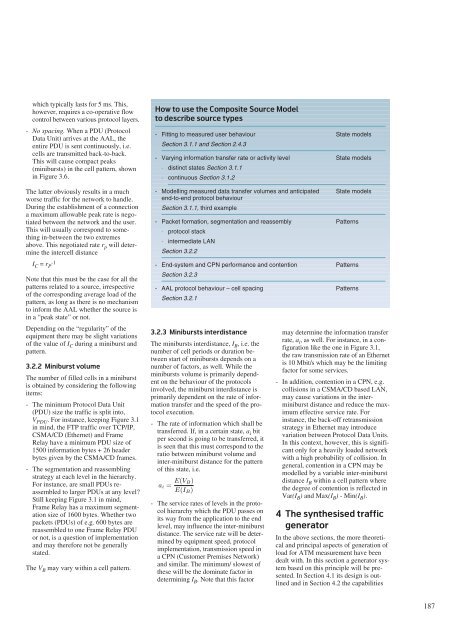Contents Telektronikk - Telenor
Contents Telektronikk - Telenor
Contents Telektronikk - Telenor
You also want an ePaper? Increase the reach of your titles
YUMPU automatically turns print PDFs into web optimized ePapers that Google loves.
which typically lasts for 5 ms. This,<br />
however, requires a co-operative flow<br />
control between various protocol layers.<br />
- No spacing. When a PDU (Protocol<br />
Data Unit) arrives at the AAL, the<br />
entire PDU is sent continuously, i.e.<br />
cells are transmitted back-to-back.<br />
This will cause compact peaks<br />
(minibursts) in the cell pattern, shown<br />
in Figure 3.6.<br />
The latter obviously results in a much<br />
worse traffic for the network to handle.<br />
During the establishment of a connection<br />
a maximum allowable peak rate is negotiated<br />
between the network and the user.<br />
This will usually correspond to something<br />
in-between the two extremes<br />
above. This negotiated rate rp will determine<br />
the intercell distance<br />
IC = r -1<br />
P<br />
Note that this must be the case for all the<br />
patterns related to a source, irrespective<br />
of the corresponding average load of the<br />
pattern, as long as there is no mechanism<br />
to inform the AAL whether the source is<br />
in a “peak state” or not.<br />
Depending on the “regularity” of the<br />
equipment there may be slight variations<br />
of the value of IC during a miniburst and<br />
pattern.<br />
3.2.2 Miniburst volume<br />
The number of filled cells in a miniburst<br />
is obtained by considering the following<br />
items:<br />
- The minimum Protocol Data Unit<br />
(PDU) size the traffic is split into,<br />
VPDU . For instance, keeping Figure 3.1<br />
in mind, the FTP traffic over TCP/IP,<br />
CSMA/CD (Ethernet) and Frame<br />
Relay have a minimum PDU size of<br />
1500 information bytes + 26 header<br />
bytes given by the CSMA/CD frames.<br />
- The segmentation and reassembling<br />
strategy at each level in the hierarchy.<br />
For instance, are small PDUs reassembled<br />
to larger PDUs at any level?<br />
Still keeping Figure 3.1 in mind,<br />
Frame Relay has a maximum segmentation<br />
size of 1600 bytes. Whether two<br />
packets (PDUs) of e.g. 600 bytes are<br />
reassembled to one Frame Relay PDU<br />
or not, is a question of implementation<br />
and may therefore not be generally<br />
stated.<br />
The V B may vary within a cell pattern.<br />
How to use the Composite Source Model<br />
to describe source types<br />
- Fitting to measured user behaviour State models<br />
Section 3.1.1 and Section 2.4.3<br />
- Varying information transfer rate or activity level State models<br />
⋅ distinct states Section 3.1.1<br />
⋅ continuous Section 3.1.2<br />
- Modelling measured data transfer volumes and anticipated State models<br />
end-to-end protocol behaviour<br />
Section 3.1.1, third example<br />
- Packet formation, segmentation and reassembly Patterns<br />
⋅ protocol stack<br />
⋅ intermediate LAN<br />
Section 3.2.2<br />
- End-system and CPN performance and contention Patterns<br />
Section 3.2.3<br />
- AAL protocol behaviour – cell spacing Patterns<br />
Section 3.2.1<br />
3.2.3 Minibursts interdistance<br />
The minibursts interdistance, IB , i.e. the<br />
number of cell periods or duration between<br />
start of minibursts depends on a<br />
number of factors, as well. While the<br />
minibursts volume is primarily dependent<br />
on the behaviour of the protocols<br />
involved, the miniburst interdistance is<br />
primarily dependent on the rate of information<br />
transfer and the speed of the protocol<br />
execution.<br />
- The rate of information which shall be<br />
transferred. If, in a certain state, ai bit<br />
per second is going to be transferred, it<br />
is seen that this must correspond to the<br />
ratio between miniburst volume and<br />
inter-miniburst distance for the pattern<br />
of this state, i.e.<br />
ai = E(VB)<br />
E(IB)<br />
- The service rates of levels in the protocol<br />
hierarchy which the PDU passes on<br />
its way from the application to the end<br />
level, may influence the inter-miniburst<br />
distance. The service rate will be determined<br />
by equipment speed, protocol<br />
implementation, transmission speed in<br />
a CPN (Customer Premises Network)<br />
and similar. The minimum/ slowest of<br />
these will be the dominate factor in<br />
determining I B . Note that this factor<br />
may determine the information transfer<br />
rate, ai , as well. For instance, in a configuration<br />
like the one in Figure 3.1,<br />
the raw transmission rate of an Ethernet<br />
is 10 Mbit/s which may be the limiting<br />
factor for some services.<br />
- In addition, contention in a CPN, e.g.<br />
collisions in a CSMA/CD based LAN,<br />
may cause variations in the interminiburst<br />
distance and reduce the maximum<br />
effective service rate. For<br />
instance, the back-off retransmission<br />
strategy in Ethernet may introduce<br />
variation between Protocol Data Units.<br />
In this context, however, this is significant<br />
only for a heavily loaded network<br />
with a high probability of collision. In<br />
general, contention in a CPN may be<br />
modelled by a variable inter-miniburst<br />
distance IB within a cell pattern where<br />
the degree of contention is reflected in<br />
Var(IB ) and Max(IB ) - Min(IB ).<br />
4 The synthesised traffic<br />
generator<br />
In the above sections, the more theoretical<br />
and principal aspects of generation of<br />
load for ATM measurement have been<br />
dealt with. In this section a generator system<br />
based on this principle will be presented.<br />
In Section 4.1 its design is outlined<br />
and in Section 4.2 the capabilities<br />
187

















